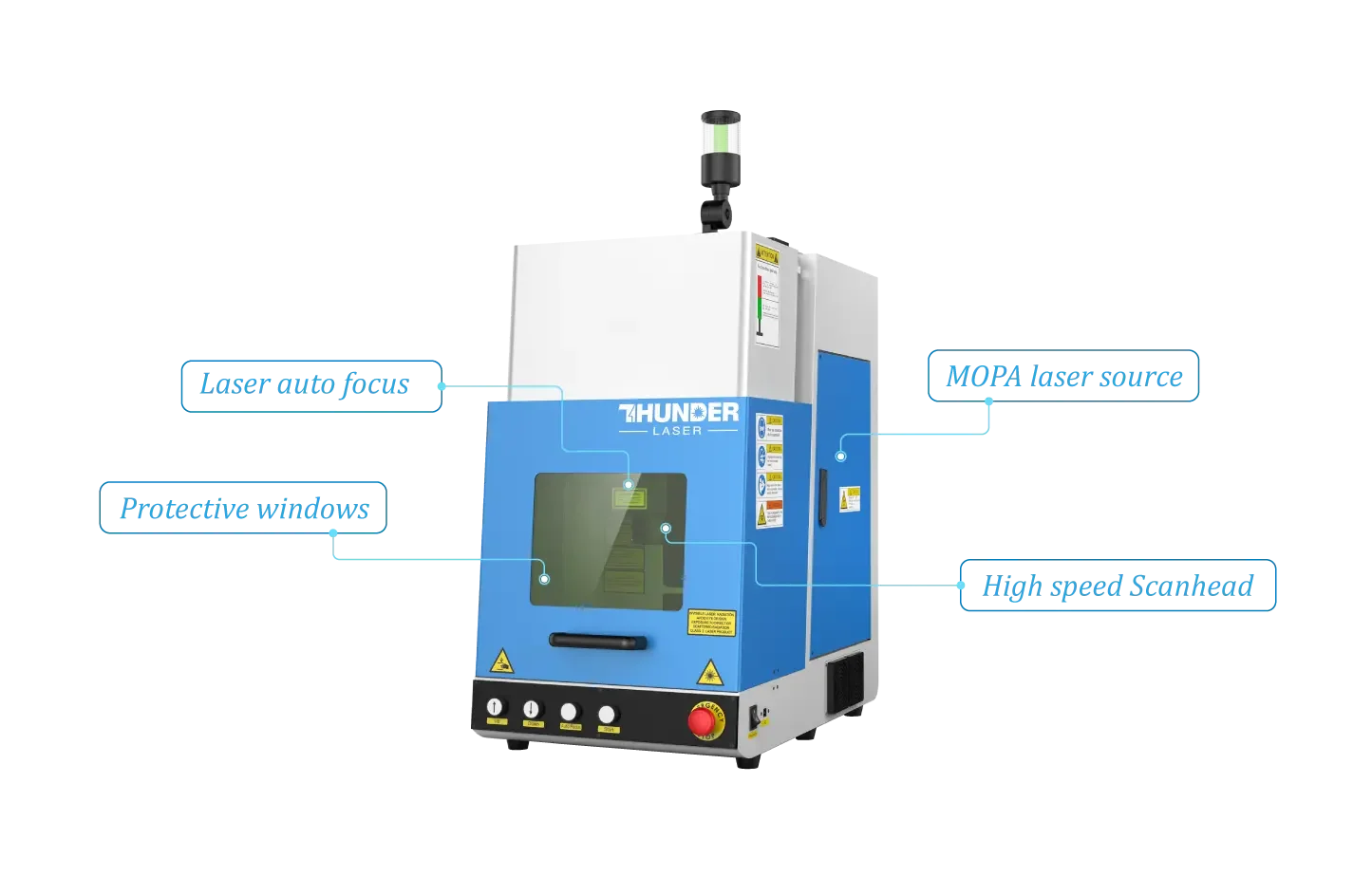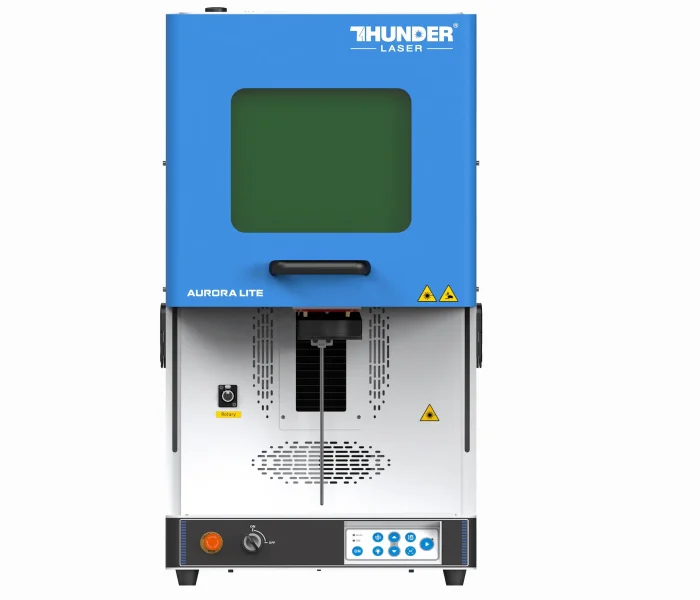The fiber laser marker offers fast, precise, and permanent marking on various materials. Commonly used in automotive, electronics, and jewelry industries, it excels at creating clear barcodes, logos, and serial numbers for product identification and quality control. This guide walks you through how to use a fiber laser marking machine effectively, from setup to maintenance. We’ll also introduce 20W, 30W, 50W, and 100W models to help you select the right option.
1. What Can You Do with a Fiber Laser Marker?

Whenever we discuss laser marking, the importance of fiber laser marking machines comes first. You can consider 20W, 30W, 50W, and 100W fiber lasers. These are the most popular fiber laser marking machines you may find best for your project.
20W fiber laser marker can mark on both metals and non-metals. Although the marking depth is not deep, it can be cost-effective. On the other hand, a 30W fiber laser marking machine creates deeper marking than 20W fiber lasers. It can also be a cost-effective solution. These devices suit part marking, jewelry engraving, and electronics component marking.
50w fiber laser marker provides a deeper marking solution than the above two devices. 50W or 100W fiber laser marking machine is suitable for deep engraving applications. Creating signage and heavy metal engraving like stainless steel are some popular applications. While choosing between these two devices, consider a 50W Raycus fiber laser marking machine. This device can fulfill all your marking requirements. Besides, the 50w fiber laser marking machine price is also within the budget. You can use a 100W fiber laser marking solution if you have deeper marking requirements.
Above all, if you are a beginner, we suggest better go for 20 watt fiber laser marking machine or 30 watt fiber laser marking machine. These two devices can laser mark popular materials you may need. Besides, the 20W fiber laser marking machine price is cheaper. Therefore, this model is the best fiber laser marking machine for beginner’s projects.
2. How to Use Fiber Laser Marker
Using a fiber laser marker correctly is essential to achieve optimal results. Understanding the importance of using the device is crucial for maximizing its capabilities. In the following, we will explore a step-by-step guide on how to use a fiber laser marker. Each step will cover essential aspects of the entire process. By following these steps, you can unlock the full potential of your fiber laser marking machine.

2.1. Step 1: Preparation
Preparation in every operation is necessary to ensure a safe and organized workspace. Regarding laser marking, proper preparation sets the foundation for successful marking. It also minimizes the risk of accidents or errors.
First, clean the working area thoroughly. Debris, dust, or obstruction interferes with the machine’s operations. They also affect the quality of the markings. A clean work area reduces material contamination. Besides, a clean work area maintains your machine’s longevity. Next, ensure your device is in the correct place on a stable surface. It is necessary to prevent vibrations or movements during the marking process. It is important to note that vibrations may lead to inaccurate or distorted markings.
Once the working area is ready, secure the material to be marked. You can use a magnet for flat materials like metal sheets. You could use a clamp to secure plastic panels in place. For irregular surfaces, you could use custom jigs or fixtures.
2.2. Step 2: Set up
Once you prepare the working area, you should properly set up your fiber laser marker. First, ensure you have connected your laser device with a stable and appropriate power source. In this case, you must follow the manufacturer’s instructions and guidelines. This step is necessary to ensure uninterrupted operation during the marking process.
Next, install the required software and drivers on the computer connected to your laser device. This software controls the marking parameters. It also imports designs or text and adjusts the settings for different materials. Therefore, choosing the right software is necessary. In this case, you can seek assistance from the manufacturer. Thunder Laser suggests EZCad 2 and EZCad 3 software for all their fiber laser marking machines.
After installing the right software, configure the settings based on the material and the desired marking depth. Configuring the settings includes adjusting the focal length and position of the laser beam. The correct power levels, speed, and laser beam position ensure precise alignment with the desired marking area. Overall, it enhances the overall accuracy of the process.
2.3. Step 3: Marking Process
Once your fiber laser marker is appropriately set up, follow the proper steps for the actual marking process. First, import the desired design, text, or barcode into the software (EZCad or LightBurn). The laser software is generally compatible with standard image formats (bmp, jpg, gif, tga, png, and tif). After importing the file, make sure you positioned the design correctly. Besides, you should also scale the design with the software to align with the desired marking area on the material.
Next, set the appropriate laser power, marking speed, and other parameters based on the specified material. Different materials have varying absorption and thermal conductivity properties. Therefore, proper adjustments are required to achieve optimal results. In this case, you can consult the machine’s user manual or seek expert advice to determine the suitable settings.
Above all, remember to exercise caution and follow safety guidelines when operating your laser machine. Wear safety glasses to protect your eyes from laser radiation.
2.4. Step 4: Finishing
After your fiber laser marker completes marking, it’s essential to consider the finishing touches. This step is necessary to enhance the overall appearance and durability of the marked surface.
First, conduct the visual inspection for quality, accuracy, and depth. Carefully examine the marked surface under appropriate lighting conditions. This step is necessary to ensure clear and legible markings that meet the desired specifications. You can also check for any inconsistencies, errors, or imperfections.
If you notice any debris or residue on the marked surface, remove it using suitable cleaning methods. We recommend using non-abrasive and non-damaging cleaning agents and tools. Choosing these agents and tools is necessary to avoid damaging or altering the markings. Consider using lint-free cloths, alcohol wipes, or specialized cleaning solutions. In this case, you can follow the manufacturer’s or supplier’s instructions for guidelines. Sometimes you may need additional post-processing steps to achieve the desired final appearance.
2.5. Step 5: Maintenance
This last step is usually not the latest in the marking process. Instead, proper maintenance determines your laser marker’s overall performance and longevity. This step focuses on three key aspects: cleaning the lens, replacing the consumable parts, and keeping the updated software.
Regular cleaning involves removing dust or debris from your laser machine and its components. Over time these residues can accumulate on these components. This accumulation affects the quality and accuracy of the laser beam. Use appropriate cleaning tools and methods recommended by the manufacturer. It is important to note that abrasive materials or harsh chemicals could damage the surface.
In addition to cleaning, replacing consumable parts as the manufacturer recommends is essential. For example, protective filters can degrade over time. Regular replacement ensures that your laser machine operates at its peak efficiency.
Furthermore, keeping the software updated is crucial to enhancing functionality and performance. Regularly check for updates and install them as recommended by the manufacturer.
Regular maintenance practices maximize the lifespan and performance of your laser machine. It ultimately ensures consistent and high-quality results for your marking needs.
3. Expert Tips for a Fiber Laser Marker
In the earlier sections, we outlined the basic steps for using a fiber laser marking machine. While following these steps helps achieve consistent results, real improvement often comes from experience and technique. Below are some expert-recommended practices to help you operate more safely, maintain output quality, and maximize your machine’s productivity.

3.1. Know Your Fiber Laser Marker Thoroughly
Start by familiarizing yourself with your specific fiber laser model. Read the user manual carefully, attend any available training sessions provided by the manufacturer, and don’t hesitate to consult with technical experts for deeper insights into advanced features and settings.
3.2. Understand Material-Specific Settings
Different materials respond differently to laser energy. Use material compatibility charts and recommended parameters to guide your setup. When in doubt, seek guidance from professionals to avoid trial-and-error damage.
3.3. Always Perform Test Runs
Before laser marking final products, conduct a test on a similar surface. This helps fine-tune the laser’s power, speed, and frequency settings while minimizing errors and reducing material waste—especially important for new users.
3.4. Prioritize Safety Measures
Laser beams can pose serious risks if mishandled. Always wear appropriate eye protection and follow the operational safety guidelines laid out by the manufacturer.
3.5. Maintain and Calibrate Regularly
Routine maintenance and timely calibration are essential for optimal machine performance. This reduces downtime, prevents premature wear, and extends the machine’s service life.
3.6. Document Your Parameters
Keep a log of the most effective settings for different materials and applications. This record not only speeds up future setups but also ensures consistent quality across repeat jobs.
3.7. Seek Expert Support When Needed
If you encounter challenges, don’t hesitate to consult specialists. Thunder Laser, a trusted Chinese fiber laser marking machine provider, offers expert support, tips, and troubleshooting solutions that can help you achieve the best possible results.
Conclusion
Fiber laser markers offer unmatched precision, durability, and versatility across industries. Whether you’re engraving metals, coding parts, or customizing products, understanding how to operate and optimize your equipment ensures long-term success and consistent results.
FAQs About Fiber Laser Marker
Q1. What materials cannot be marked with a fiber laser marker?
Fiber lasers are ineffective on transparent materials like glass or certain plastics, as the laser wavelength may pass through without interacting.
Q2. Can I mark curved or irregular surfaces with a fiber laser marker?
Yes, with a rotary attachment, fiber lasers can mark curved items like tumblers or rings. The attachment rotates the object, keeping the laser in focus for accurate engraving on rounded surfaces.
Q3. How much does a fiber laser marker cost?
Prices vary depending on power, size, and features. Entry-level models can start around $3,000-$5,000, while industrial-grade machines can exceed $50,000.
Q4. Is laser marking permanent and resistant to fade off?
Yes, fiber laser marks are permanent, high-contrast, and resistant to abrasion, heat, and chemicals—suitable for industrial-grade traceability.
Q5. Can I mark anodized aluminum in color with a fiber laser machine?
Yes. You can create dark or light contrast on anodized aluminum. For vibrant color effects, stainless steel is more suitable.


.png) International
International
 United States
United States
 Brasil
Brasil
 Canada
Canada
 Costa Rica
Costa Rica
 Mexico
Mexico
 Česká
Česká
 Romania
Romania
 Polska
Polska
 Ireland
Ireland
 Portugal
Portugal
 Lietuva
Lietuva
 Россия
Россия Deutschland
Deutschland
 Britain
Britain
 Україна
Україна
 France
France
 Sverige
Sverige
 Italia
Italia
 Norway
Norway
 Denmark
Denmark
 Ελλάδα
Ελλάδα
 한국
한국
 中国
中国
 ประเทศไทย
ประเทศไทย
 中国香港
中国香港
 Israel
Israel
 中國臺灣
中國臺灣
 India
India
 پاکستان
پاکستان
 پශ්රී ලංකා
پශ්රී ලංකා
 ジャパン
ジャパン
 Australia
Australia
 New Zealand
New Zealand
 South Africa
South Africa